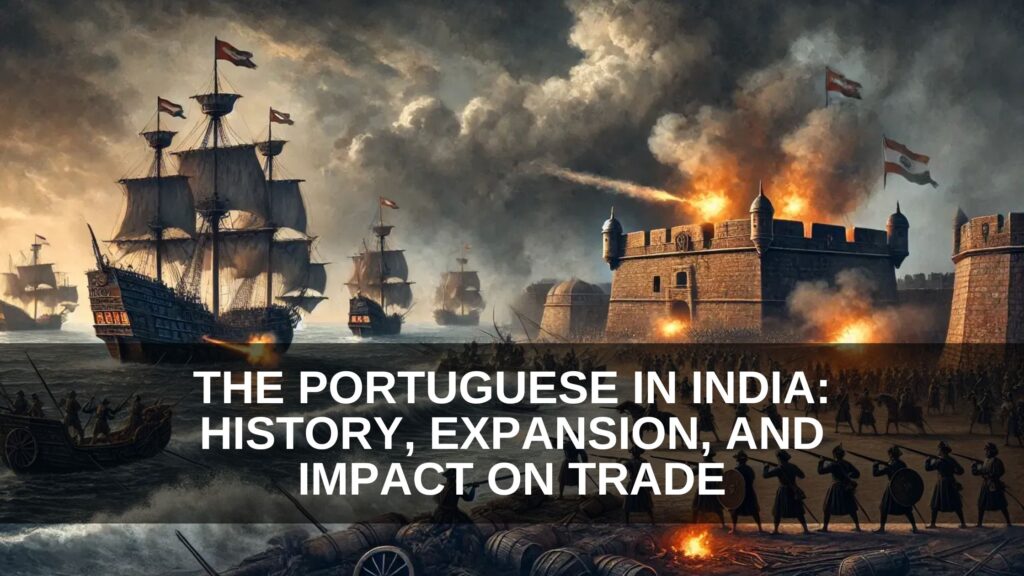The Portuguese were the first Europeans to discover a direct maritime route to India, marking a significant shift in global trade and geopolitics. On May 20, 1498, Portuguese merchant Vasco da Gama became the first European to arrive in Calicut, a crucial seaport in South India. This discovery ended the Arab traders’ long-standing monopoly on Indian Ocean commerce and opened the gateway for European colonial expansion in Asia.
Download notes of Delhi Sultanate
Factors Leading to Arrival Portuguese in India
Several factors contributed to the Portuguese exploration and eventual colonization of India:
- Rising Demand for Luxuries in Europe – Since Roman times, European markets had a high demand for Eastern goods, including silk from China, spices, and chemicals from India and Southeast Asia.
- Fall of Constantinople (1453) – The Ottoman Turks’ conquest of Constantinople disrupted the traditional trade routes, forcing Europeans to seek alternative paths to Asia.
- Logistical and Human Resources – Spanish and Portuguese explorers received financial and technical support from Northern European merchants, particularly those from Genoa, Italy.
- Royal Patronage – Portuguese ruler Dom Henrique (Henry the Navigator) played a crucial role in financing and encouraging maritime expeditions.
- Renaissance Influence – The Age of Exploration was fueled by Renaissance ideals that encouraged curiosity, innovation, and expansion.
- Treaty of Tordesillas (1494) – This agreement between Spain and Portugal allowed Portugal exclusive rights to explore routes in the Indian Ocean, solidifying its dominance in the region.
Establishment of Portuguese Presence in India
Portuguese First Factory in India
The Portuguese established their first factory in India in 1502 at Cochin (present-day Kochi), which became a crucial hub for their spice trade. This marked the beginning of European colonial trade dominance in Asia.
The Arrival of Vasco da Gama
Guided by a Gujarati pilot named Abdul Majid, Vasco da Gama arrived in Calicut in 1498 and was warmly received by the local ruler, Zamorin. However, tensions arose between the Portuguese and Arab traders, who had long controlled the spice trade on the Malabar Coast.
Expansion of Portuguese Factories
- 1500 – Pedro Alvarez Cabral arrived in Calicut but faced resistance. In retaliation, he attacked Arab ships and killed their crew.
- 1501 – Vasco da Gama returned to India, establishing a trading factory at Cannanore.
- 1505 – Portuguese King Manuel I appointed Francisco De Almeida as the first Viceroy of India. He implemented the “Blue Water Policy” to dominate Indian Ocean trade.
- 1509 – Afonso de Albuquerque succeeded Almeida and fortified Portuguese holdings, acquiring Goa from the Sultan of Bijapur in 1510.
- 1529 – Nino da Cunha moved the Portuguese headquarters from Cochin to Goa and expanded into Bengal.
- 1534 – Treaty of Bassein: The Sultan of Gujarat, Bahadur Shah, ceded Bassein to the Portuguese in exchange for military support against the Mughal Emperor Humayun.

Portuguese Military Strategy
The Portuguese used a combination of military might and strategic fortifications to maintain their dominance:
- Occupation of Coastal Islands – Strong fortifications in places like Diu helped them resist Mughal and Gujarati attacks.
- Naval Superiority – They pioneered ship technology, using cannons and multi-decked vessels to assert control over the Indian Ocean.
- Trade Monopoly – The Portuguese monopolized valuable goods like pepper, ammunition, and war horses, imposing strict regulations on trade.
Impact of the Portuguese on Indian Trade and Society
- Trade Expansion – The Portuguese linked India to Japan and the Philippines, introducing new economic opportunities.
- Agricultural Introductions – They brought crops like potatoes, maize, and peanuts from the Americas.
- Spread of Christianity – Missionary efforts led to conversions, particularly in Goa, where the Portuguese implemented strict religious policies.
- Rise of Monopolization – They enforced trade monopolies and frequently seized ships that defied their rules, leading to conflicts with local merchants.
Decline of Portuguese Power
Despite their early success, Portuguese influence waned by the 17th century due to several factors:
- Arrival of Other European Powers – The Dutch and the British challenged Portuguese dominance. In 1612, the Battle of Swally resulted in a decisive English victory.
- Acts of Piracy and Dishonest Trade Practices – Their aggressive trade policies alienated local rulers and the Mughal Empire.
- Slave Trade in Hooghly – Portuguese traders engaged in the slave trade, prompting Mughal Emperor Shah Jahan to expel them from Bengal.
- Rise of the Marathas – The Marathas captured Bassein and Salsette in 1739.
- Discovery of Brazil – Portugal shifted its focus to South America, reducing its commitment to Indian territories.
Download notes of The Bhakti Movement in India
While the Portuguese had a localized impact, particularly in Goa, their influence on the Indian subcontinent was not as profound as that of the British and French.
However, they were the first European colonizers in India and the last to leave, with Goa, Daman, and Diu remaining under Portuguese control until 1961. Their role in the power struggles between Indian dynasties shaped the subcontinent’s political landscape for over four centuries.


